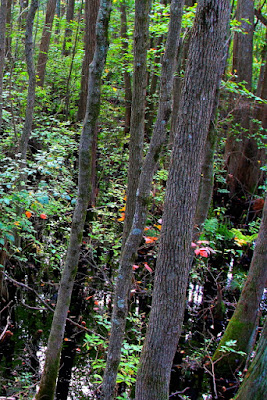There are two ferries at the Jamestown-Scottland crossing; so we met the other ferry in the middle of the James River while we were on our way to the Scotland port, and the other ferry was on its way to the Jamestown Port.
Once on the south side of the river, we stopped at Bacon's Castle; but found that is was closed for renovations.
Next stop was the Chippokes Plantation State Park. In addition to the old plantation, there were many wild flowers and we even encountered a deer that was not camera-shy. The Chippokes Farm and Forestry Museum is also located in this area.
 |
| Photographer Unknown |
As is typical around rural america, many of the once beautiful old houses have been abandoned and are being reclaimed by nature.
We were told that the 1751 Faulcon House (also known as the Warren House and Rolfe-Warren House) at Smith's Fort Plantation is so well laid-out that it was reproduced numerous times by different people at different locations.
The plantation was originally Captain John Smith's "New Fort" that was established in 1609 across the James River from James Fort; but was soon abandoned due to dry rot and rat infestation. The land was later giver to John Rolfe and Pocahontas as a dowry from Chief Powhatan.
In 1933 the Association for the Preservation of Virginia Antiquities acquired the property after it had been restored by John D. Rockefeller, Jr.
Fort Huger was known as the "Gateway to the Confederate Capital," and the site is just a short distance from the community of Smithfield. To my surprise, this was not a popular place to visit. As I walked around the self-guided tour path it appeared that no one had visited the site in several days - maybe weeks! There are no existing fort structures, but there are a number of cannons and earthen berms that are still in-place.
One of the walking trails around the fort site crosses a pitch and tar swamp in several places, but fortunately there there was an elevated wooden walkway.
The Isle of Wright County Museum in Smithfield contains the World's Oldest Ham and various interactive exhibits and displays interpreting colonial history in the area. I almost did not have the opportunity to see the World's Oldest Ham because the museum was just closing for the day when I arrived; but after explaining that I had traveled all the way from Las Vegas just to see the ham, they agreed to stay open long enough so that I could have a quick tour of the museum.
Apparently there are different stories about how the ham was overlook for a number of years, but the museum's version is that "In 1902, a cured ham was overlooked, and for 20 years, the ham hung from a rafter in a packing house. By 1924, the pet ham was kept in an iron safe which was opened daily for guests to view. Advertised as the world's oldest Smithfield ham, Gwaltney fashioned a brass collar for the ham and took it to shows and expos to exhibit the preservative powers of his smoking method. The ham was featured in Ripley's "Believe It Or Not" in 1929, 1932 and 2003."
















































No comments:
Post a Comment